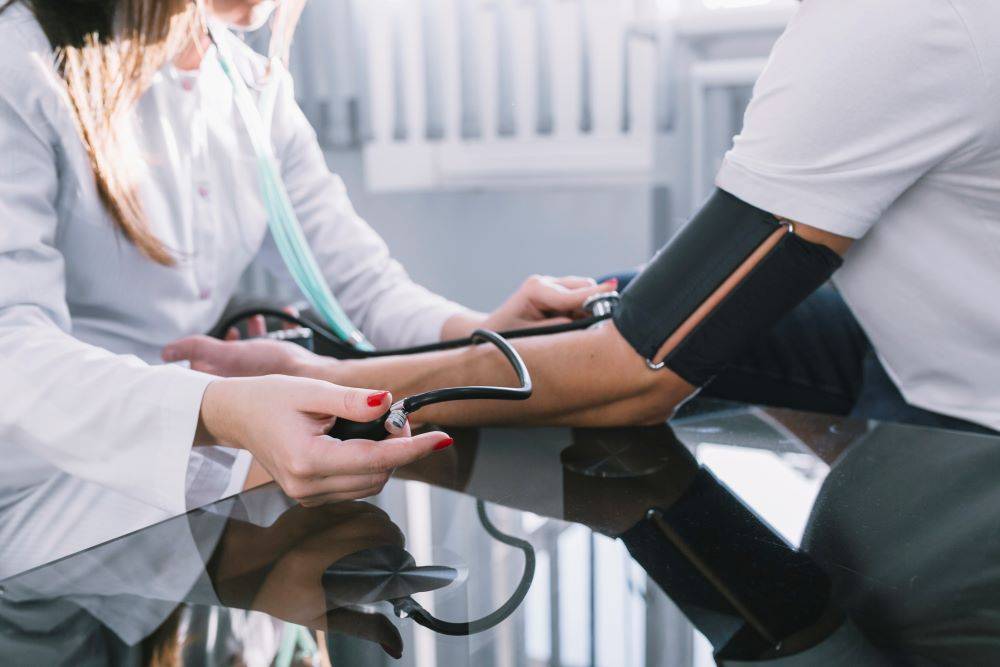Hypertension is a medical condition in which arterial blood pressure stays above usual levels for a long time, putting too much stress on the circulatory system. Health problems like stroke, kidney failure, and heart disease can happen because of this. Even though hypertension (HTN) may seem like a simple issue, the different types and stages of HTN have different causes, symptoms, and even different treatment options.
This post will talk about the different types of high blood pressure and its various stages.
What are the different types of Hypertension?
Here are different types of hypertension:
1. Primary Hypertension:
Primary or essential hypertension affects around 95% of individuals with high blood pressure. It is termed as "essential" hypertension, since it worsens over time and has no known cause. Numerous studies indicate that it may be related to factors such as diet, exercise, smoking status, and stress levels.
Most primary hypertensive patients are unaware of their condition until the illness has progressed far along. Therefore, it's important to regularly monitor your blood pressure so that you can identify any changes as soon as they occur.
2. Secondary Hypertension:
Primary hypertension doesn't have a clear reason that can be found and handled, while secondary hypertension does. It may strike anybody at any age. Certain conditions may lead to secondary hypertension, such as:
○Sleep apnea
○Hormonal conditions (Cushing's syndrome, thyroid disease)
○Contraceptive tablets
○Decongestants
○Excessive alcohol consumption over an extended length of time
3. Malignant Hypertension:
It happens, when your blood pressure exceeds 180/120 mmHg, it happens. It is a life-threatening condition, and can damage your heart and kidneys.
Although the exact etiology of malignant hypertension is unknown, it is often linked to other medical conditions such chronic kidney disease (CKD), disorders of the adrenal glands, or medications that cause blood vessels to constrict.
Malignant hypertension is most often characterized by a severe headache that is insensitive to over-the-counter analgesics. In addition, there could be dizziness or loss of consciousness, nausea, vomiting, dysphagia, shortness of breath, and confusion or blurred vision.
4. White coat Hypertension:
It is also called isolated clinic hypertension. It happens when blood pressure readings are higher in a medical setting, like a hospital or doctor's office, than when they are taken at home or in a less stressful place. This can happen because of the stress and worry that come with being in a clinical setting, especially for people who are afraid of hospitals or medical treatments.
The American Heart Association released a study that found 15 to 30% of people who were told they had high blood pressure actually had white coat hypertension. To differentiate white coat HTN from other types of high blood pressure, doctors may recommend ambulatory blood pressure monitoring (ABPM). For this, you have to wear a gadget all day and night that checks your blood pressure. ABPM gives more exact readings than taking measurements every once in a while.
5. Gestational Hypertension:
It is also known as pregnancy-induced hypertension (PIH), and usually starts after 20 weeks of pregnancy and affects about 10 to 13 percent of all pregnancies.
There are some factors that can make a woman more likely to get gestational hypertension, including:
○First pregnancy
○More than 40 years old age
○Having more than one baby
○Being overweight
○A history of long-term high blood pressure
6. Masked Hypertension:
People with masked hypertension, also called "hidden" or "occult" hypertension, have blood pressure readings that are within the normal range when they are in a medical setting but are higher when they are not.
According to studies, people with hidden hypertension are more likely to have heart diseases like heart attacks and strokes than people whose blood pressure readings are usually normal.
What are the Stages of Hypertension?
To manage your high blood pressure properly, you need to know about its different stages.
1. Prehypertension:
People with blood pressure between 120/80 mmHg and 129/80 mmHg have prehypertension. In other words, their blood pressure results are always higher than usual, but not yet high enough to be called hypertension.
For people in the United States, the American Heart Association says that almost 30% of them have prehypertension. A person with prehypertension might get headaches, nosebleeds, or shortness of breath once in a while, but most of the time they don't show any signs at all.
2. Stage I hypertension:
At stage 1 hypertension, the blood pressure level stays between 130/80 and 139/89. At this stage, your heart has to work harder to pump blood through vessels.
According to studies, people with stage 1 HTN are almost twice as likely to have a heart attack or stroke as people with average blood pressure.
3. Stage II hypertension:
Stage 2 HTN needs medical attention right away, because at this stage, the systolic BP is over 140 mmHg and the diastolic BP is over 90 mmHg. When blood pressure stays above the average level for a long time, it raises the risk of heart disease, stroke, and other health problems.
4. Hypertensive crisis:
A hypertensive crisis is an abrupt and severe rise in blood pressure that can lead to major health problems. It is typically characterized by a blood pressure reading of 180/120 mmHg or higher. This problem needs medical help right away because it could cause liver damage, a stroke, a heart attack, or even death.
The takeaway message
People often call high blood pressure the "silent killer" because it doesn't usually show any signs until it gets really bad. In other words, you might not know you have high blood pressure for years. Before deciding if a person has high blood pressure, doctors usually take two or more readings at different times. It is crucial to get your blood pressure checked regularly, especially if you have any risk factors.
References:
1.Carretero, O. A., & Oparil, S. (2000). Essential hypertension. Circulation, 101(3), 329–335.
2.Franklin, S. S., Thijs, L., Hansen, T. W., O’Brien, E., & Staessen, J. A. (2013a). White-coat hypertension. Hypertension, 62(6), 982–987.
3.Mohammad, J., Khan, K. A., Hafeez, I., Rather, H. A., & Lone, A. A. (2022). Role of ambulatory blood pressure monitoring in hypertensive patients having controlled office blood pressure. Indian heart journal, 74(6), 474–477.
4.Centers for Disease Control and Prevention. (2022, April 28). Hypertensive disorders in pregnancy and mortality at delivery hospitalization - United States, 2017–2019. Centers for Disease Control and Prevention.
5.Shi, X., Zhang, K., Wang, P., Kan, Q., Yang, J., Wang, L., & Yuan, H. (2019). Association of masked uncontrolled hypertension and cardiovascular diseases in treated hypertensive patients. Archives of medical science : AMS, 16(3), 538–544.
WRITTEN BY Checkme
1 Kommentar
Great information on the types of blood pressure! Thanks
Hinterlasse einen Kommentar
Related Blogs
Recommended Products
Subscribe for special promotions,
healthy knowledge, and more!





